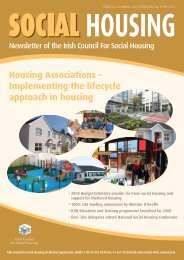National Housing Strategy for People with a Disability 2011 - 2016
National Housing Strategy for People with a Disability 2011 - 2016
National Housing Strategy for People with a Disability 2011 - 2016
You also want an ePaper? Increase the reach of your titles
YUMPU automatically turns print PDFs into web optimized ePapers that Google loves.
advocates (where appropriate) and disability services (statutory and voluntary) and otheragencies as required. <strong>Housing</strong> applications from people <strong>with</strong> disabilities must be activelymanaged by authorities and interagency cooperation should continue throughout theapplication process.Allocating Accommodation: Local authorities must be cognisant of engaging <strong>with</strong> otherstakeholders when allocating housing to applicants <strong>with</strong> disabilities, <strong>for</strong> example, <strong>with</strong> HSEmental health services <strong>for</strong> applicants <strong>with</strong> a mental health disability or liaising <strong>with</strong>occupational therapy services when allocating housing to a person <strong>with</strong> a physical or asensory disability who requires particular adaptations. Local interagency protocols should bedeveloped between relevant stakeholders to facilitate this type of liaison on a <strong>for</strong>malisedbasis.Innovative responses: <strong>Housing</strong> authorities are not only the providers of traditional socialhousing options, but also act as catalysts to enable people <strong>with</strong> disabilities to access a rangeof appropriate housing solutions. Authorities are responsible <strong>for</strong> identifying housing need,determining, in conjunction <strong>with</strong> relevant agencies, the most appropriate individualisedsolution, and engaging <strong>with</strong> the relevant service providers in order to successfully meetidentified need. Formal interagency cooperation between all relevant stakeholders canassist in identifying innovative and individualised responses, where necessary. Theproposed <strong>Housing</strong> and <strong>Disability</strong> Steering Groups, as set out below, can act as a catalyst <strong>for</strong>the development of such responses.7.5 Many people <strong>with</strong> disabilities require ongoing supports after they have obtained adwelling, e.g. personal, health and care services, tenancy supports, or community and socialsupports. Responsibility <strong>for</strong> the funding and delivery of these supports lies <strong>with</strong>in the remitof various Departments and agencies and requires a more joined up approach than currentlyexists. The Support Costs Protocol, implemented in March <strong>2011</strong>, sets out a framework <strong>for</strong>better coordination of capital and revenue funding <strong>for</strong> health service related support costs<strong>for</strong> projects provided by approved housing bodies <strong>for</strong> people <strong>with</strong> disabilities. More broadlyit is recommended that a <strong>for</strong>malised engagement framework <strong>for</strong> the funding of housing andrelated supports is undertaken by relevant Departments as part of the multi-annualestimates process.Interagency protocols7.6 The primary statutory agencies involved in the delivery of housing and relevantsupports to people <strong>with</strong> disabilities are the housing authorities and the HSE. Many otheragencies also have key roles to play, including approved housing bodies, the Department ofSocial Protection, landlords and representative organisations of landlords, estate agents,74









